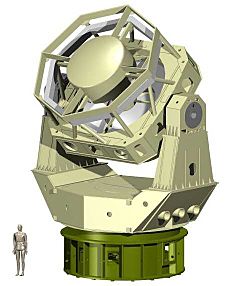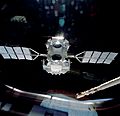Telescope facts for kids
A telescope is a super important tool for astronomy. It helps us see things far away in space, like stars and planets, by gathering light and making them look bigger and brighter. Some telescopes use curved mirrors, some use curved lenses, and some use both!
Contents
What is a Telescope?
Telescopes make distant objects look much bigger, brighter, and closer. This helps us study them in more detail. While Galileo was the first person to use a telescope for astronomy, he didn't invent it. The very first telescope was actually invented in the Netherlands in 1608.
Not all telescopes are used for looking at space. Some common ones you might know are binoculars, camera lenses, and spyglasses.
How Telescopes Work
When you use a telescope with your eye, you need a special part called an eyepiece. This eyepiece has small lenses that magnify the image even more. Without it, your eye can't focus on what the telescope sees.
However, if a telescope is connected to a camera or other scientific tools, you don't need an eyepiece. The camera or tool can capture the image directly.
Different Kinds of Telescopes
Most large telescopes used by scientists are designed to study things we already know about in great detail. A few are built to search for new things, like unknown asteroids. Telescopes made to work with cameras instead of just your eye are sometimes called "astrographs."
Telescopes for Everyone (Amateur Telescopes)
You don't have to be a scientist to use a telescope! Many people enjoy looking at the night sky as a hobby. These are called amateur telescopes. They are usually smaller and don't cost too much. One popular type for hobbyists is the Dobsonian, which is a kind of Newtonian telescope.
Seeing Beyond What We Can See
When we talk about telescopes, we usually think about seeing light that our eyes can detect. But there are also telescopes that can "see" other kinds of wavelengths of light that we can't.
Infrared Telescopes
Infrared telescopes look a lot like regular telescopes. However, they have to be kept very cold. This is because all warm things give off infrared light. If the telescope itself was warm, its own heat would get in the way of seeing the infrared light from space!
Radio Telescopes
Radio telescopes look very different. They are like giant radio antennas, often shaped like huge dishes. They pick up radio waves coming from space.
X-ray and Gamma Ray Telescopes
X-ray and Gamma ray telescopes face a special challenge. These powerful rays can go right through most metals and glass. To solve this, their mirrors are shaped like many rings nested inside each other. This way, the rays hit the mirrors at a very shallow angle and bounce off.
Why Space Telescopes Are Important
Many X-ray and Gamma ray telescopes are space telescopes. This means they are put into orbit around Earth. Very little of this radiation reaches the Earth's surface because our atmosphere blocks it. Other space telescopes are also put in orbit so that the Earth's atmosphere doesn't interfere with their observations.
Telescopes are mainly used for looking at amazing things in space, like the stars, planets, and galaxies!
Related pages
Images for kids
-
The 100 inch (2.54 m) Hooker reflecting telescope at Mount Wilson Observatory near Los Angeles, USA
-
The "onion" dome at the Royal Observatory, Greenwich housing a 28-inch refracting telescope with a remaining segment of William Herschel's 120-centimetre (47 in) diameter reflecting telescope (called the "40-foot telescope" due to its focal length) in the foreground.
-
The primary mirror assembly of James Webb Space Telescope under construction. This is a segmented mirror and its coated with Gold to reflect (orange-red) visible light, through near-infrared to the mid-infrared
-
Modern telescopes typically use CCDs instead of film for recording images. This is the sensor array in the Kepler spacecraft.
-
The Very Large Array at Socorro, New Mexico, United States.
-
Six views of the Crab nebula supernova remnant, viewed at different wavelengths of light by various telescopes
See also
 In Spanish: Telescopio para niños
In Spanish: Telescopio para niños















